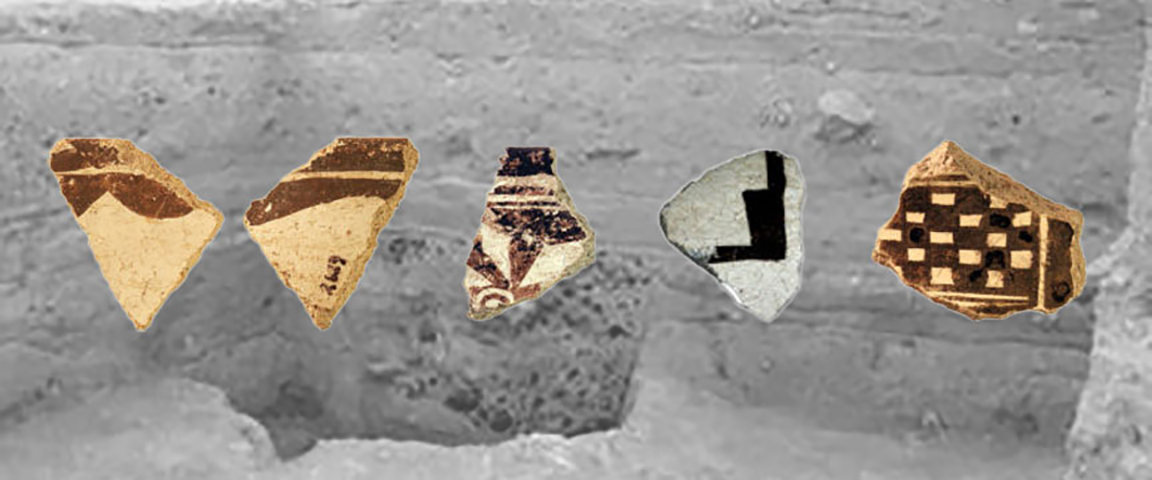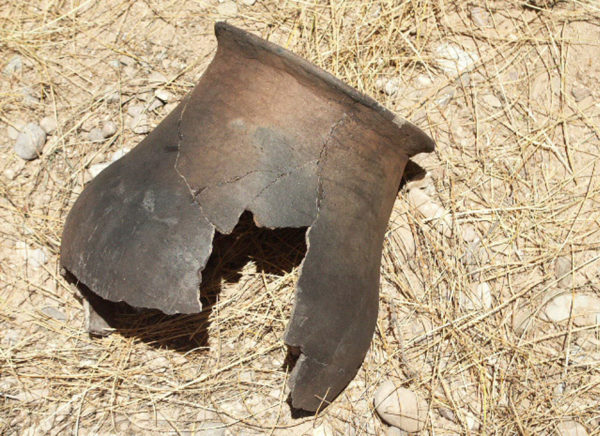
Zuni Pottery from the Presidio San Agustín del Tucson
Desert Archaeology historical archaeologist Homer Thiel and ceramic analyst Jim Heidke discuss the ceramics used by 18th-century residents of the Presidio, including some surprising souvenirs brought home by Spanish soldiers from a long-distance military expedition.
The Presidio San Agustín del Tucson was a Spanish and Mexican period (AD 1775-1856) fortress located in downtown Tucson. During its 81 years of existence, between 400 and 500 people lived inside the fort, including about 100 to 110 soldiers. Nearby lived another 500 O’odham and Apache people. San Agustín was the northernmost presidio in the Pimería Alta area of southern Arizona and northern Sonora, and was quite isolated economically, with the nearest stores 100 miles away in Sonora at Imuris or Arizpe.
People living in the fort relied on pottery manufactured by the local O’odham for cooking and serving food. The O’odham made plain ware and red ware vessels, some of the latter having painted designs.

A Papago Black-on-red chocolatero pot from the Presidio San Agustín del Tucson. (photo by Homer Thiel)
The Presidio families ate from brightly-colored majolica dishes manufactured in the Mexico City area. A small number of the Native American ceramic sherds found during archaeological excavations in the Presidio came from much farther away, from the Zuni, Hopi, and Western Pueblos of northern Arizona and northwestern and west-central New Mexico.
In January and February 2019, Desert Archaeology conducted excavations to the west of the Historic Pima County Courthouse, built in 1929. The new January 8th Memorial, commemorating the tragic mass shooting that occurred on January 8, 2011 and left six people killed and 13 others injured, is to be built at this location. The work uncovered remnants of the foundations of the 1868 Pima County Courthouse and the 1880s City Hall and Jail. A surprise find was the cesspool for the 1881 Pima County Courthouse, constructed in the late 1880s and covered in 1895 with a roof that was held up by long iron railroad rails. Beneath these American Territorial period features, we encountered a thick trash layer dating to the Presidio times.

Drone photograph of the January 8th Memorial excavations. The railroad ties over the cesspool are visible as parallel lines in the center of the photo. (courtesy Randy Metcalf, Pima County Communications Office)
This project, and earlier work within and adjacent to the Presidio, revealed that trash disposal was haphazard during the years soldiers and their families lived at the fort. Any available hole or surface was used for dumping refuse. The smell from human and animal waste, along with butchering debris, must have been horrible by today’s standards. The thick trash layer we found was located a short distance to the west from the eastern wall of the Presidio, in an area where people probably mined the soil to use for adobe bricks and mortar. The soil mining left a large depression in the ground that people living in nearby households filled with their trash, transforming it into the midden we encountered during our 2019 excavations. The area sloped down to the west and south, and during heavy rainfalls water running downhill brought along dirt and more trash. The surviving portions of the midden were between 20 to 60 cm deep.
We excavated a sample of the midden. What did we find? Most common were animal bones—primarily cattle, but also sheep, pig, chickens, and horse or mule. We also found a lot of Native American ceramics and Mexican majolica pottery, as well as small amounts of Chinese porcelain. Other items included musket balls, gun flints, two musket parts, buttons, and buckle fragments.
We also found 29 Native American white ware sherds that were dramatically different from the plain ware or red on brown ceramic vessels created by the Tohono O’odham living near the Presidio. These pots were made from a white-firing clay. Red and black paint was used to create designs on the surface of bowls and jars. Analyst Jim Heidke and University of Arizona Regents’ Professor of Anthropology Barbara Mills examined the sherds and concluded that 21 pieces were from bowls, two from jars, and six from vessel forms that could not be determined. Four of the sherds were Zuni Polychrome, which are thought to date from around AD 1800 to 1900, although the beginning date might be a little earlier.
So how did these vessels travel to Tucson? Captain José Antonio de Zúñiga took command of the Presidio San Agustín del Tucson in 1794. Born in Cuatitlán, Mexico, he was 40 years old, and had gradually risen in rank after enlisting in the military in 1772, serving as the Comandante of the San Diego Presidio before coming to Tucson. Zúñiga was Comandante of the Tucson Presidio until at least 1810.
On Thursday, April 9, 1795, Zúñiga led a group of soldiers on an expedition, marching eastward from Tucson before turning to the north. On April 19th they battled Apache warriors. In early May, they arrived at the Zuni villages in northwestern New Mexico. After a short visit, they returned to Tucson in late May. It is likely that while at Zuni, many of Zúñiga’s soldiers bartered for small pottery vessels that they brought back to Tucson, maybe as gifts for family members.
Previous work in the Presidio had found smaller numbers of Zuni, Hopi, and Western Pueblo sherds, and most of the historic Native American sites recorded in southern Arizona had sherds from similar vessels. This suggests that while Zúñiga’s men brought many northern vessels back to Tucson in 1795, trade between the Native Americans of southern Arizona and the distant pueblos was ongoing during the Presidio era and persisted into the Mexican period.
The January 8th Memorial archaeological work was funded by Pima County.
Resources
Pima County produced a short video featuring aerial footage of the excavations and an interview with Homer Thiel:





